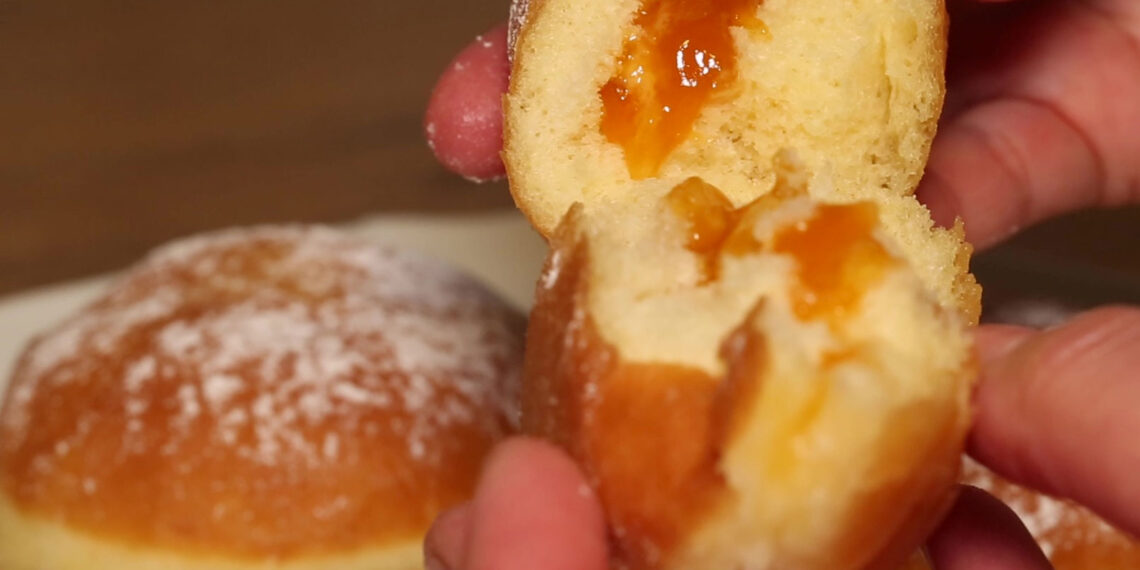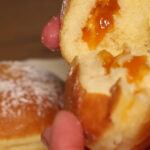With our simple Faschingskrapfen recipe, you’ll achieve soft and fluffy krapfen with ease! With helpful tips and a video tutorial, you can bake these delightful treats yourself—even as a beginner. Try this trusted carnival recipe today!
Jam-Filled Krapfen
Ingredients
- ½ kg 500 g plain wheat flour (Type W 480/405 or 700/550)
- 1 tsp salt
- ¾ cube fresh yeast 30 g
- Approx. ¼ L lukewarm milk
- 40 g butter
- 40 g sugar
- 4 egg yolks
- 1 shot of rum helps reduce fat absorption when frying; don’t worry, the alcohol evaporates during baking
- Optional: lemon zest
- 1 L fat for frying lard and/or sunflower oil
- 200 ml finely strained apricot jam for filling
- Powdered sugar for dusting
Instructions
Activate the yeast
- Crumble the fresh yeast into the lukewarm milk, add two pinches of sugar, whisk, and let it sit for a few minutes.
- ⚠️ *Make sure the milk is not too hot (max. 35°C), or the yeast will lose its effectiveness!*
Prepare the dough
- Meanwhile, gently melt the butter. Add the prepared milk mixture, egg yolks, the remaining sugar, and rum, then mix well.
- In a large bowl, combine the flour and salt. Pour in the egg yolk-milk mixture and knead into a smooth dough—using a hand mixer with dough hooks, a stand mixer, or traditionally by hand. 😉
- The dough should be smooth and elastic, pulling away from the sides of the bowl.
Let the dough rise
- Cover the dough and let it rise in a warm, draft-free place (such as an oven at max. 40°C) until doubled in size.
- After the first rise (approx. 30 minutes), punch the dough down and let it rise again (**another 15 minutes**).- This double rising process makes the dough fine-textured and airy.
Shape the krapfen
- Knead the dough again. Using a dough scraper, cut small pieces and shape them into smooth, round balls by rolling them with gentle pressure on a lightly floured surface.
- - Alternatively, use a tablespoon to scoop portions directly from the bowl, knead briefly, and roll into balls.
- - For even sizes, weigh each dough piece (50–70 g per krapfen, depending on preference).
Let them rise again
- Place the shaped krapfen onto a floured cloth, gently flatten them slightly, cover with another cloth, and let them rise again.
Frying
- Heat lard or oil in a deep pan or pot to approximately 150°C.- To check the temperature, dip a wooden stick into the oil—if small bubbles appear, it's ready!- Place the krapfen into the hot fat with the top side down and fry for 3–4 minutes, covered.- Once they turn a beautiful golden brown, flip them and fry uncovered for another 3 minutes.- Tip: Fry a test krapfen first to ensure the oil temperature is right!
Draining & cooling
- Remove the freshly fried krapfen with a slotted spoon and let them drain on paper towels to absorb excess oil. Let them cool slightly.
Filling
- Stir the finely strained apricot jam until smooth and fill it into a pastry injector or piping bag with a filling nozzle.- If the jam is too thick, warm it slightly.- Carefully insert the nozzle into the pale ring on the side of the krapfen and inject the filling.
Final touch
- Dust the fluffy krapfen generously with powdered sugar and enjoy! 🎉
Video
What Are Faschingskrapfen?
Krapfen, also known as Faschingskrapfen or Berliner (as our German neighbors call them), are sweet, deep-fried yeast pastries. In Austria, krapfen are traditionally dusted with powdered sugar and filled with apricot jam. Our readers love this recipe:
“The best recipe. It always turns out perfectly.” – Karina
“Today, I chose your recipe, and I’m thrilled! The krapfen are airy and light, with no air pockets, and they taste amazing!” – Felizitas
Why Do These Faschingskrapfen Always Turn Out Perfectly?
The secret lies in the carefully selected ingredients and a proven preparation method. Using butter, egg yolks, and a small splash of rum makes the dough especially smooth and prevents it from absorbing too much fat when frying. Additionally, letting the dough rise twice ensures a fine, airy texture and the characteristic fluffy consistency.
Frequently Asked Questions
Why does the characteristic white ring appear on Faschingskrapfen?
It forms because the krapfen continue to rise while frying in hot fat. 🙂
How long does the preparation take?
The entire preparation takes about 2 hours, including the resting time for the yeast dough.
How can I prevent the krapfen from absorbing too much fat when frying?
To reduce fat absorption, add a small splash of rum to the dough. Also, the frying fat should remain at a constant temperature of about 150–160°C. If the fat is too cold, the krapfen will soak up oil; if it is too hot, they will brown on the outside but remain undercooked inside.
How do I get especially fluffy krapfen?
The dough should rise multiple times (at least twice) to develop a fine and airy texture. Proper kneading is also crucial—it should be smooth and pull away from the sides of the bowl.
Can Faschingskrapfen be frozen?
Yes, krapfen can be frozen. It is best to freeze them without sugar and filling, then thaw them at room temperature. Warm them briefly in the oven and fill them fresh afterward.
What fillings can be used?
Besides apricot jam, raspberry jam, vanilla cream, or chocolate fillings are popular alternatives.
Interesting Facts About Faschingskrapfen
Year after year, these fluffy, soft pastries with their signature light ring and fruity jam filling are a beloved treat. And because they taste so good, Austrians consume 100 million krapfen in just one year! However, with around 400 kilocalories per piece, they are not exactly a “light” indulgence.
The Faschingskrapfen is characterized by its round, ball-like shape and the pale ring in the middle, which forms as the dough expands further while frying. Baked to a golden yellow, the finished krapfen is slightly crispy on the outside and soft and fluffy inside. Besides the classic apricot jam and powdered sugar version, various other jams, powidl (plum spread), vanilla, and nougat cream fillings, as well as sugar and chocolate glazes, are also used.
Fun fact: The amount of jam filling is legally regulated in the Austrian Food Codex (Chapter B 18 “Bakery Products,” Paragraph 62), requiring at least 15% of the krapfen’s finished weight to be jam.
When Were Krapfen Invented?
According to an interview in the magazine Steirische Wirtschaft with linguist and culinary researcher Helmut Klug from the University of Graz, the term krapfen appeared as early as the 8th century—originally as a hearty food for winter. However, these early versions were very different from today’s filled round krapfen. Initially, they were made from noodle dough with savory fillings, such as the Schlickkrapfen. Later, there were fasting krapfen without meat.
Yeast, which is essential for today’s krapfen, was not introduced into the recipe until the 18th century. However, one key feature has remained unchanged throughout history: krapfen are always deep-fried, whether sweet or savory.
One example of this deep-fried tradition is the Steirerkrapfen from Upper Styria. It has little in common with a Faschingskrapfen, aside from its name and the fact that it is fried in lard. Other sweet krapfen varieties include Bauernkrapfen, Stanglkrapfen, and Spagatkrapfen, among many others.
For Erich Handl, master of the Styrian confectioners’ guild, and our team, the classic Faschingskrapfen is, of course, filled with apricot jam. The dough must be rich in egg yolks and made with butter—a tradition we proudly uphold in our recipe.


